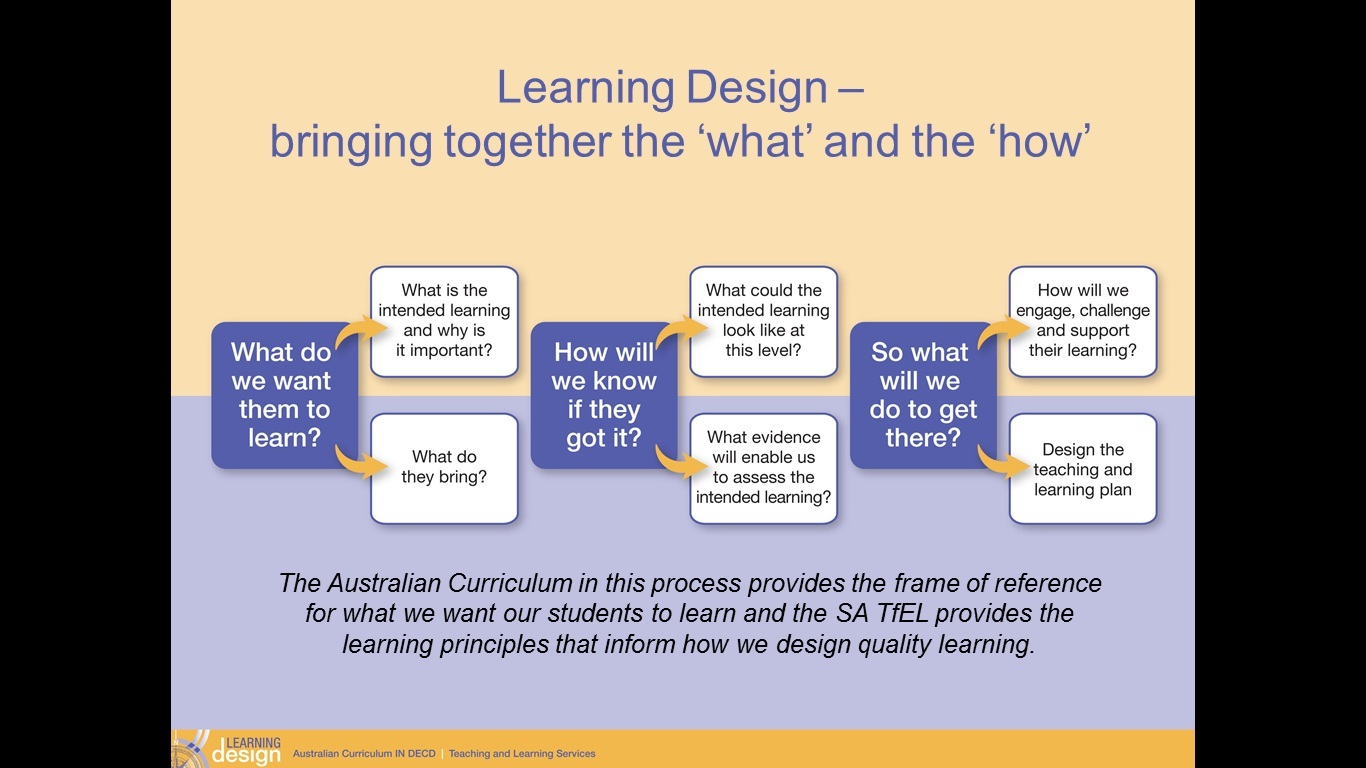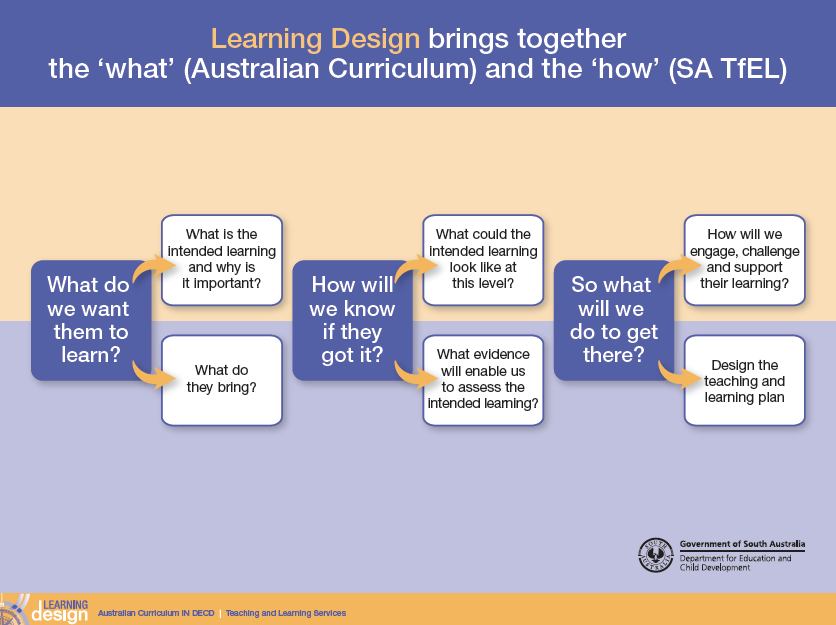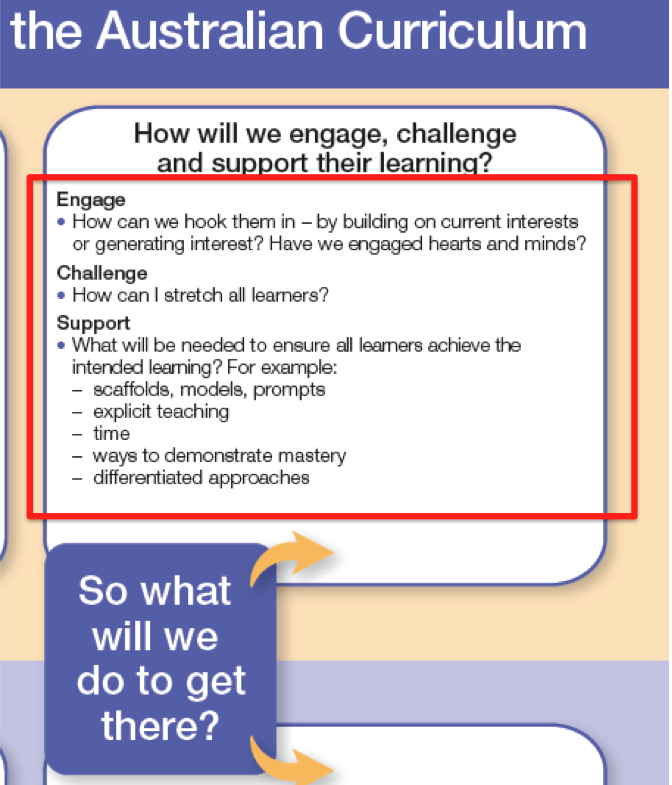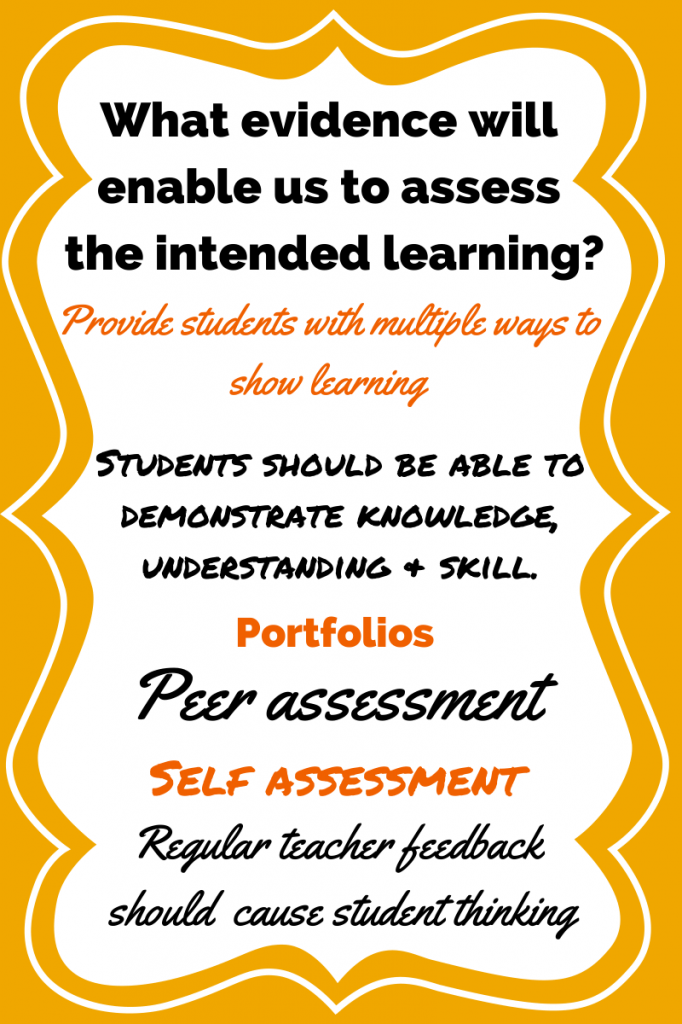If you are keen to have this document alongside you as you plan your programs for 2017 then click here. Download the PDF which gives detailed explanations for each of the six areas mentioned in the video.
learning design


Planning for assessment of and for student learning
How we design our assessment tasks determines the quality of information we get back from our students. In turn, this impacts on how well we can then move our students forward and assess and report on student achievement to parents. Planning for assessment of and for student learning is a key part of the Learning Design process.
Learning Design

When planning for assessment of and for learning we need to consider what strategies we will use to allow students to demonstrate their learning.

Note: Formative assessment (assessment for learning) is any assessment used at the beginning of and during instruction to check student understanding with the purpose of moving students learning forward. Formative assessment includes self assessment and peer assessment practices. Summative assessment is any assesment that is used to make a final judgement or assign a grade for the purpose of reporting student performance to parents.
We need to ensure that our formative and summative assessment tasks:
- Allow us to identify the next step in the learning process.
- Allow students to present learning in different ways.
- Allow students to present their learning in a way that supports them. For example, a drawing, video or audio explanation may be more appropriate than a written explanation for a student with low-level writing skills.
- Directly connect with the verbs in the achievement standard. For example, if students are required to “identify and select a range of sources” then the task must provide the opportunity to do this.
- Allow students to achieve the Standard at an ABOVE level (A or B grade). Closed tasks, like T or F and multiple choice, may be appropriate at times but can limit students ability to deeply explain concepts and show learning at a higher level.
- Engage students through connections with their own lives and interests where possible (easier said than done).
- Challenge students to not just find and repeat facts but to analyse, debate, create, evaluate and apply their knowledge to demonstrate understanding.

Finally, the support we provide students to apply their knowledge and understanding is critical. The environment we create in our classrooms to support student learning goes a long way to determining the depth and level of knowledge students are able to demonstrate.
"The purpose of assessment is to improve learning, inform teaching, help students achieve the highest standards they can and provide meaningful reports on students’achievement." ACT Government Education & Training
To access online professional development in the area of Assessment for Learning click HERE.
Sources
Leading learning – Making the curriculum work for us
ACT Teachers Guide to Assessment
PBAS Professional Learning Community
At the beginning of the year a decision was made to use some staff meeting time (twice a term) to have professional discussions. These discussions would be teacher led and require the sharing of practice with the rest of the staff on a particular topic. We did this on a student free day last year with the topic “Storing and using evidence of learning for assessment”. Three teachers presented their work in this area and other teachers commented on how useful the presentations and following discussions where.
This week will see our first PLC discussion on the topic of Programming. Joelene, Kelly and Justin have kindly agreed to share their programming processes with us.
While these three have agreed to talk it would be great if everyone came prepared to contribute in some small way to the discussion either by sharing aspects of their own programming or be willing to ask questions of those presenting.
Points for discussion could include the following:
1. How do you prepare a program? What type of format do you use?
- Bring examples to share/show.
2. Do you have a detailed plan or work from a broad overview or do you have both?
- What do these look like?
- How does your day to day planning look is it a different format to your more detailed plans or is it the same document?
3. How do you go about organising your resources and assessment tasks?
4. Is there flexibility in your plan?
5. How do you incorporate the Australian Curriculum into your planning?
6. Do you consider all aspects of Learning Design when programming or just some of them?
If anyone is interested in further reading around programming here is a draft document titled Planning for implementing – Australian Curriculum from the QLD Curriculum and Assessment Authority which discusses curriculum planning in schools. Page 5 provides a great overview for teachers titled “Elements of effective planning”.
Learning Design – What do my students already know?
Tanya has very kindly allowed me to share her classroom observation which occurred in week 3. Tanya’s focus is around Finding out what students already know. This closely links with the Learning Design process and TFEL.
Domain 4 Personalise and connect learning. Element: 4.1 build on learners’ understandings the teacher identifies students’ prior knowledge and cultural practices as a starting point for curriculum.
I have inserted Tanya’s observational notes based on our new 2015 observational proforma. Please have a read and hopefully it provides some help and inspiration with your own planning in this area.
Learning Design – very quickly, what is it?
One of the 6 areas of Learning Design, What do they bring? requires us to carefully consider the beliefs, misconceptions and experiences students have. “What students bring” should not only be considered in relation to the content being taught but also other experiences students have had that impact on their attitude towards learning and their relationship with the teacher and other students.
To become effective at finding out what our students bring we need strategies to help us elicit this information. I have provided some resources that hopefully give some practical strategies that can easily be used in the classroom to achieve the aim of finding out what students bring to your classroom.
Resource 1: Click on the diagram to go to the Cornell University Centre for Teaching and Excellence website
Resource 2: Strategies to find out what students know
Revisiting Learning Design – Design the teaching and learning plan
This is the final post in the ‘Revisiting Learning Design’ series of posts. I hope that they have at least prompted you to think about aspects of Learning Design and how they are applied to your teaching and learning programs.
The final aspect of Learning Design is ‘Design the teaching and learning plan’. This is where everything comes together and forms the foundation for a unit of work.
Revisiting Learning Design – How do we engage, challenge and support student learning?
Engagement could be described in two ways, compliance engagement and deep engagement. According to David Price (Learning Futures Engaging Students, 2010) deep engagement encompasses the following:
Is every student challenged to reach his/her personal best or just those who ‘do’ school well? We have a professional responsibility to push, extend and support ALL students no matter how hard this might be at times.
How do we stretch our students? This is not easy when in one class we might face levels of ability ranging from reception to year 8 (this is not an exaggeration if you consider Paul’s current class). Challenging and supporting all students is a challenge we face daily.
Revisiting Learning Design – What evidence will enable us to assess the intended learning?
Designing assessment tasks that will allow students to address the Achievement Standards and content descriptors at an ‘A’ level is important. If we only ever produce tasks that allow for a satisfactory achievement and don’t address the deeper learning aspects of the curriculum we are doing a disservice to our students.
Consideration must be given to formative assessment. How do we assess students lesson by lesson to see where they are at and then provide feedback to move their learning forward? What type of summative assessment will be used and at what points during the topic?
How do we collect evidence of student learning? Documenting student work and keeping it on file in some way is important, examples include:
- Student work books
- Digital portfolios (student compiled or teacher compiled)
- Hard copy portfolios (filing cabinet or take home book)
Portfolios of work are useful at report writing time, they provide concrete evidence of student learning. Looking at a spreadsheet with a grade provides an indication of what was achieved but the sample work in portfolios/student workbooks allows us to write more accurate comments in student reports.
Revisiting Learning Design – What does the intended learning look like?
As teachers we need to have a clear understanding of what quality learning for any particular task looks like. We then need to be able to communicate this with our students. Using the Australian Curriculum content descriptors, Achievement Standards, quality work samples are ways to help achieve this. Using rubrics with clearly thought out criteria or for younger children a set of clearly written steps to help them navigate a task successfully are also ways that we can assist our students to understand what is required to be successful.
How can we expect our students to reach high levels of learning if we do not let them in on the secrets to what “high quality” learning is?
Revisiting Learning Design – What do they bring?
Here is the second poster in my ‘Revisiting Learning Design’ series of posts. Understanding what our students bring in terms of understandings, beliefs, misconceptions, prior knowledge etc is important. It gives us a foundation, a starting point for a topic and assists us with what direction we might take with that topic.
Importantly we must plan how we will elicit this information from our students. Having a range of strategies to find out this information is an important part of our job as teachers.
All information in the posters is taken from the Learning Design documents created by the DECD Teaching and Learning Services. Click here to visit the acleadersresource.sa.edu.au site.
Revisiting Learning Design – What is the intended learning?
Here is the first poster in the ‘Revisiting Learning Design’ series of posts. Understanding what we are required to teach using the Australian Curriculum is important. What is more important is how we connect that with students lives and the real world. Also important is developing a ‘big idea’ along with essential questions that when answered will give students a deeper understanding of the concepts and content being covered.
This post and the next 5 are not intended to be an in depth review of Learning Design Their purpose is to provide an opportunity to think about the different aspects of Learning Design and consider our current practice.
All information in the posters is taken from the Learning Design documents created by the DECD Teaching and Learning Services. Click here to visit the acleadersresource.sa.edu.au site.









